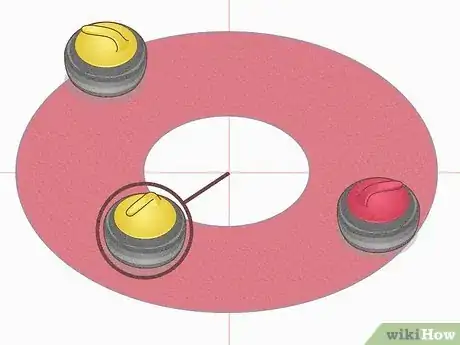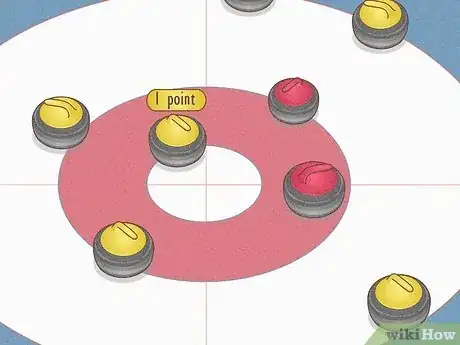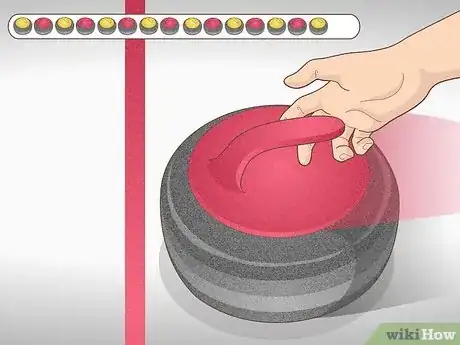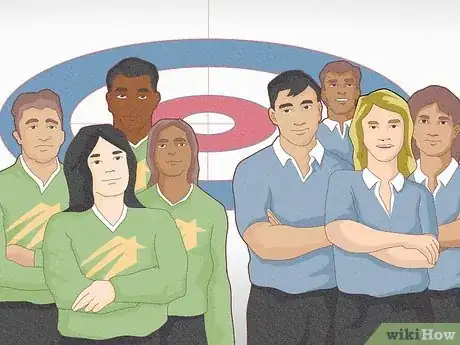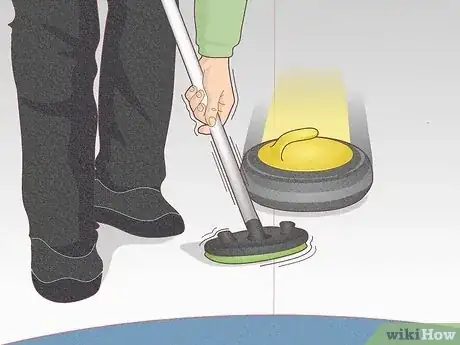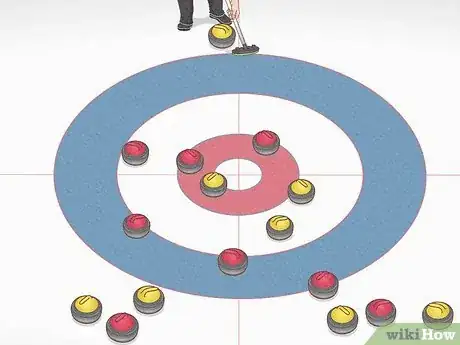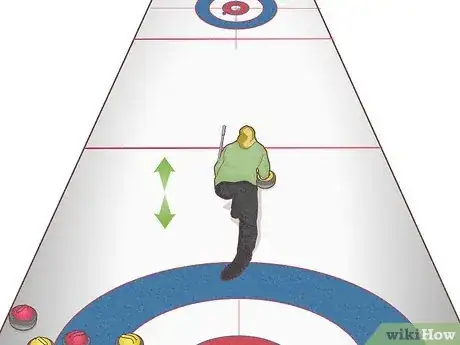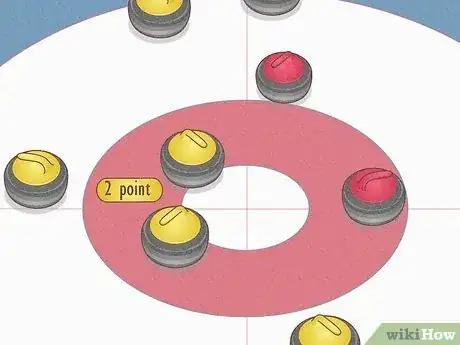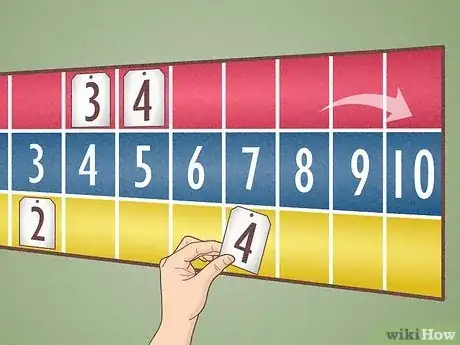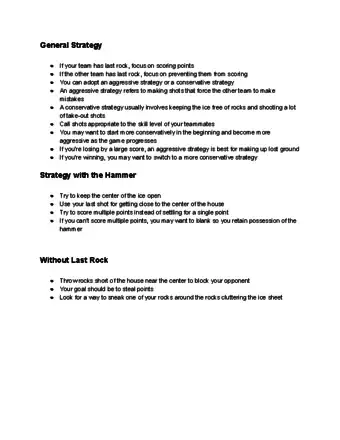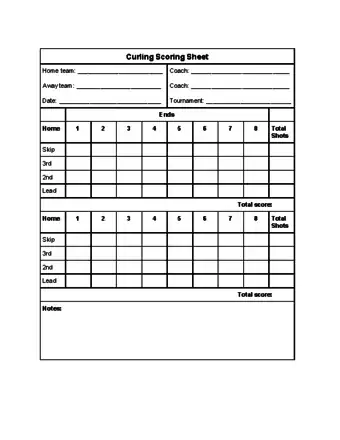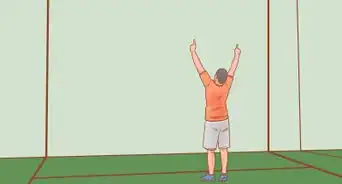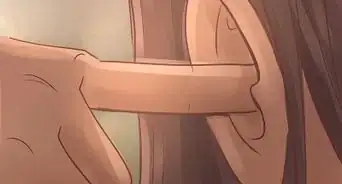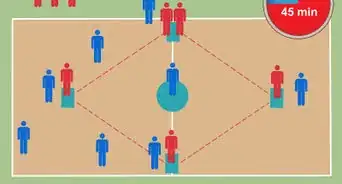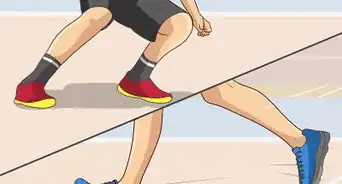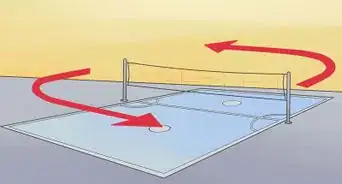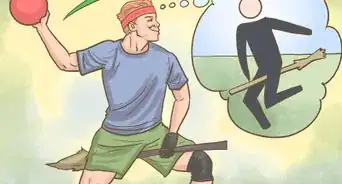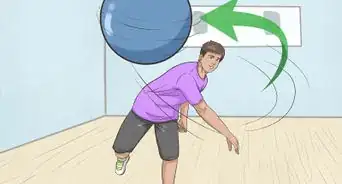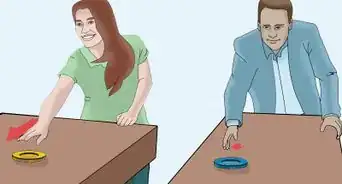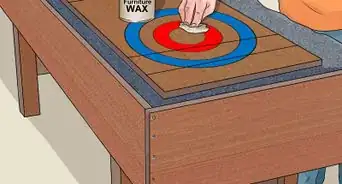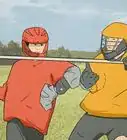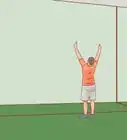This article was co-authored by wikiHow staff writer, Jennifer Mueller, JD. Jennifer Mueller is a wikiHow Content Creator. She specializes in reviewing, fact-checking, and evaluating wikiHow's content to ensure thoroughness and accuracy. Jennifer holds a JD from Indiana University Maurer School of Law in 2006.
wikiHow marks an article as reader-approved once it receives enough positive feedback. In this case, several readers have written to tell us that this article was helpful to them, earning it our reader-approved status.
This article has been viewed 339,495 times.
Learn more...
Curling might look confusing when you first start watching, but the goal of the game is deceptively easy: get your team's stones closest to the "button"—the center of the bullseye known as the "house." If you can do that, your team scores at least 1 point, plus 1 additional point for every stone closer to the center than your opponent's closest stone. But with each team taking turns throwing stones, strategy becomes complex as each "end" (like an inning in baseball) progresses. Read on to learn everything you need to know about how to score in curling and the strategy it takes to win a curling match. Good curling!
Things You Should Know
- Take turns with the opposing team to throw a total of 16 stones toward the house at the other end of the ice. The team with the stone closest to the button wins the end.
- Score 1 point for the stone closest to the center of the button.
- Score 1 additional point for each stone that is closer to the center of the button than the opponent's closest stone.
- Play 8-10 ends in a full curling match. The team with the most points wins the match.
Steps
Tallying the Score
-
1Determine which stone is closest to the center of the target. Curlers shoot stones (disk-shaped rocks with handles) toward a target painted on the ice at the other end of the sheet. That target is called the "house," and the smallest circle is called the "button." The closest stone to the center of the button is called the "shot rock." Usually, players just eyeball the stones and agree on which stone is closest. There are lines crossing through the exact center of the button (the tee line) and you're looking for the stone closest to that. Whichever team threw that stone wins the end.[1]
- If each team has a stone super close, you might bring out a micrometer (curlers usually just call this "the stick") and actually measure to see which is closest. Curling is all about fair play and sportsmanship, so you rarely see this—usually the teams just agree.
- No stones in the house at all? That's called a blank end—nobody scores.
-
2Find the opponent's stone that is next closest to the button. You'll sometimes hear this stone referred to as "2nd shot rock." Like with the shot rock, players will typically just eyeball and agree on which stone is the 2nd shot rock. They might walk around the house a bit to get a different angle if the shots are close.[2]
- If the players had to bring out a micrometer to measure and determine the shot rock, then the competing stone is automatically the 2nd shot rock.
Advertisement -
3Add points for stones closer than the opponent's closest stone. The team that wins gets additional points for all the stones they have inside or touching the house—but only for those that are closer to the center than the 2nd shot rock. Confused? A couple of examples will help:[3]
- Team Red has the shot rock with 6 stones in the house. Team Yellow has the 2nd shot rock with a stone just inside the smallest circle of the house. The shot rock is the only stone closer to the center of the button, so Team Red only scores 1 point.
- Team Red has the shot rock with 6 stones in the house, just as before. But this time, Team Yellow's closest stone is in the outer circle of the house. All of Team Red's stones are closer to the center of the button than Team Yellow's closet stone, so Team Red scores 6 points.
-
4Pass the hammer to the team that lost the end. The team that lost gets an advantage in the next end, because they get to throw the last stone (called "the hammer"). If you had a blank end where nobody scored, the team that had the hammer carries it through to the next end.[4]
- This is why sometimes it's better strategy to let your opponent win the end so you can get the hammer. That's an especially strong strategy toward the end of the match when the score is close.
- Which team starts with the hammer? This is usually decided by a coin toss or something similar. In some tournaments, the hammer is assigned.
- When a team manages to score without the hammer, it's called a "steal."
Playing an End
-
1Organize 2 teams of 4 players each. In regular curling, you have 2 teams with 4 players. There's another type of curling known as "mixed doubles," but don't worry about that for now. Each member of a curling team plays a specific position:[5]
- Lead: delivers the first 2 stones for their team; should be a strong sweeper and good at throwing guards
- Second: delivers the 3rd and 4th stones for their team; should work well as a team sweeping with the lead
- Vice: takes over the skip's duties while the skip is throwing; should be good at all shots but especially draws
- Skip: throws the last stone of the end, which often determines whether the team will score; directs overall strategy
-
2Take turns throwing (sliding) stones down the "sheet" of ice. When it's your turn, crouch down with your back foot against the "hack" (like a starting block in track). Push off from the hack to lunge forward with the stone. Release the stone before it crosses the first big horizontal line, called the near "hog line."[6]
- Typically, the thrower will give the handle of the stone a bit of a twist as they release—this will cause the stone to curl as it moves down the ice, and gives the sport its name.
- Be careful that no part of your body crosses the near hog line before you release the stone—otherwise, that stone won't count.
- The stone must reach the far hog line to be considered in play. If it doesn't, it'll be moved off the playing surface. It takes a lot of practice to know exactly how hard you need to throw the stone to get it to do what you want it to do!
-
3Sweep your teammates' stones when you're not throwing. For each stone, 2 team members position themselves on either side of the sheet just past the near hog line. Once the stone gets to them, they start rubbing the ice in front of the stone with their brooms. Sweeping reduces the friction under the stone so it glides more smoothly to the position they want.[7]
- The skip (or vice, if the skip is throwing) directs the sweepers based on their perspective of the stone's movement. This is where curling gets loud. If the skip wants a lot of sweeping, you'll hear, "Hard! Haaaaard!"
- Don't touch the stone with your broom or any part of your body while you're sweeping. If you do, you "burn" the stone and it's removed from play.
- Once a stone makes it into the house, the opposing team can sweep it to try to get it to move away from the spot where you wanted it to stop (or "freeze").
-
4Talk about strategy throughout the end. The skip directs the overall strategy of each end, with the other players giving their input where relevant. There's typically quite a bit of chatter among teammates between shots, with the skip using their broom to target the throw. There are 3 basic types of shots:[8]
- Guards: light shots thrown toward the front of the house to block opponents and protect the shot rock (a stone close to or on the button)
- Draws: direct shots thrown specifically to reach the house (and hopefully the button) and stay ("freeze") there
- Takeouts: heavy shots intended to strike an opponent's rock and knock it out of play
-
5Continue playing until all 16 stones are thrown. The teams alternate shots, with each player throwing a total of 2 stones for their team. The skip stays down at the house until it's their turn to throw, directing strategy for their team.[9]
- When the end is finished, the teams look at the position of the stones and tally the score. While there can be disagreements if 2 stones are super close to each other, it's usually pretty quickly decided who gets points and how many they get.
Playing a Full Match
-
1Switch playing directions each end. You might have noticed that there's a house on both ends of the sheet. Having to pass the stones down after every end would really wear down the ice. Instead, you play the stones from the other direction to get them back down (and this is why "ends" are called "ends").[10]
- Play continues the same way, you're just moving in the opposite direction.
-
2Tally the score at the finish of each end. Only 1 team can score points in each end, although the score is cumulative to the end of the match. After each team has thrown 8 stones, figure out the shot rock and 2nd shot rock, then add up the score for that end.[11]
- Sometimes you'll have a stone just barely in the house (called a "biter"). Since the edges of the stone are rounded, it might not actually be contacting the house at all, but it still counts if it's across that outside line (as long as it's closer than the 2nd shot rock).
-
3Rotate through 8 to 10 ends. A competitive curling match usually lasts 10 ends, although the losing team can concede at any time if they feel the other team has an insurmountable lead. In smaller regional tournaments and leagues, you might have shorter matches of 8 ends.[12]
- Time can come into play as well. If there's a time limit, you'll know about it before you start playing. When time is up, you're usually allowed to finish the end you're on, then the match is over.
-
4Determine the winner of the match. Since the score is cumulative, the team with the most points at the end of the match is the winner, just like virtually any other team sport. If the 2 teams are tied, they might play additional ends to determine the winner.
- Ties can also be broken by "skip stones." Each of the skips throws a draw shot. The stone closest to the center of the button wins, with that skip's team taking home the match victory.[13]
Scoring Rules and Template
Community Q&A
-
QuestionHow much time does a team have to talk over strategy before throwing their stone?
 wikiHow Staff EditorThis answer was written by one of our trained team of researchers who validated it for accuracy and comprehensiveness.
wikiHow Staff EditorThis answer was written by one of our trained team of researchers who validated it for accuracy and comprehensiveness.
Staff Answer wikiHow Staff EditorStaff AnswerIt depends on the rules of the tournament or league where the team is playing. Most leagues are pretty open-ended about talking time because players in general aren't going to waste time (that would be unsportsmanlike). Tournaments typically have a maximum amount of talking time allowed per match.
wikiHow Staff EditorStaff AnswerIt depends on the rules of the tournament or league where the team is playing. Most leagues are pretty open-ended about talking time because players in general aren't going to waste time (that would be unsportsmanlike). Tournaments typically have a maximum amount of talking time allowed per match. -
QuestionWhat is the scoring process for conceded ends?
 wikiHow Staff EditorThis answer was written by one of our trained team of researchers who validated it for accuracy and comprehensiveness.
wikiHow Staff EditorThis answer was written by one of our trained team of researchers who validated it for accuracy and comprehensiveness.
Staff Answer wikiHow Staff EditorStaff AnswerIf a team concedes, the match is over. The score is whatever it was at the point the team conceded.
wikiHow Staff EditorStaff AnswerIf a team concedes, the match is over. The score is whatever it was at the point the team conceded. -
QuestionHow do you score 8 points in one end if you have only 4 stones each earning only 1 point?
 wikiHow Staff EditorThis answer was written by one of our trained team of researchers who validated it for accuracy and comprehensiveness.
wikiHow Staff EditorThis answer was written by one of our trained team of researchers who validated it for accuracy and comprehensiveness.
Staff Answer wikiHow Staff EditorStaff AnswerThere are 16 total stones, with each team throwing 8 stones, so it's possible to score a maximum of 8 points if the team gets the stone closest to the center of the button (shot rock) and all 7 other stones are in the house and closer to the center of the button than the other team's closest stone. In practice, this is extremely rare.
wikiHow Staff EditorStaff AnswerThere are 16 total stones, with each team throwing 8 stones, so it's possible to score a maximum of 8 points if the team gets the stone closest to the center of the button (shot rock) and all 7 other stones are in the house and closer to the center of the button than the other team's closest stone. In practice, this is extremely rare.
References
- ↑ http://www.secc.rocks/2021/10/learn-to-curl-scoring/
- ↑ http://www.secc.rocks/2021/10/learn-to-curl-scoring/
- ↑ http://www.secc.rocks/2021/10/learn-to-curl-scoring/
- ↑ https://www.palmettocurling.com/about/
- ↑ https://www.capitalcurlingclub.org/curling-basics.html
- ↑ https://www.capitalcurlingclub.org/curling-basics.html
- ↑ https://www.capitalcurlingclub.org/curling-basics.html
- ↑ https://www.capitalcurlingclub.org/curling-basics.html
- ↑ https://worldcurling.org/about/curling/
About This Article
To score in curling, throw 1 of your team's stones into the house during an end of play. Increase your chances of scoring by having your teammates sweep the ice in front of the stone so it travels smoothly or by taking out your opponents stones. If your team manages to get more stones closer to the center of the house than your opponents after an end, count the number of stones to total multiple points. Finally, tally up your points after 10 ends to see who wins the game. For tips on mastering the basic rules of curling and taking shots, scroll down!
